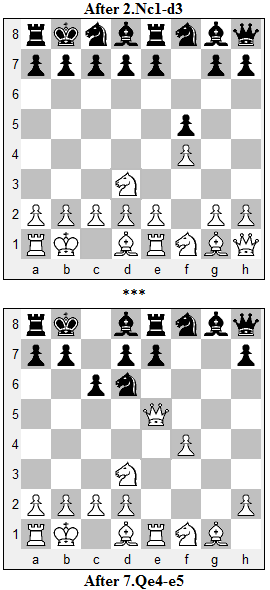The game was my first playing for a team, conducted under the system described in Parallel Games, two games against the same opponent with the same start position. Much to my dismay, the team was already losing 0-2 a short time into the match when our last board lost both his games by blitzing his moves. 'Overconfidence' was his excuse.
I won my game with White while the other team members played their games to an even result, so the team was one point down with only my game as Black remaining. The game started as SP861 RKNBRNBQ, a Queen-in-the-corner position. The first moves were 1.f4 f5 2.Nd3, reaching the position shown in the top diagram. Here I played 2...g5, planning the continuation 3.fxg5 e5, where Black has excellent play for the Pawn.
My opponent avoided this and the game continued 3.g3 gxf4 4.gxf4 c6 5.e4 fxe4 6.Qxe4 Nd6 7.Qe5, reaching the bottom diagram. White is hoping for an exchange of Queens on e5, repairing his Pawn structure and retaining the initiative.

Black can't avoid the Queen swap, but he can dictate the terms. I played the unusual idea 7...Ng6, when White has nothing better than 8.Qxh8 Nxh8. Black is not worse and has good play against the isolated f-Pawn. The game continued 9.Bg4 e6 10.Ng3 Kc7.
White launched a Queenside attack with the a-Pawn and castled O-O. Black repulsed the attack and launched a counterattack on White's weak Kingside, eventually winning a Bishop for a Knight. A long period of maneuvering set in and I finally converted my positional advantages into an extra Pawn. I wrote about the endgame in a post on my main blog, Simple Positions, Pretty Geometries.
The league's organizer, in a summary of the match, noted,
The cliffhanger of Section B delivered the teams New England [my team] and Team XLink who shared the victory with a result of 5-5. Funnily enough no draws occurred. Absolutely well worth seeing was the clash of two chess960 heavyweights at the first board. Mark with Black managed to defeat Carl in a model correspondence game.
It's always nice to win, but it's even nicer when the game has special value.

2 comments:
Mark played as Black:
SP861 RKNBRNBQ
1. f24 f75
2. Nc1-d3 g75?!
Mark, what is the name of this interesting new opening gambit that you uncovered? ;-)
Or does chess960 suffer from an inability to have its clever opening systems become named?
Until we discard the 'Random' from Fischer Random Chess, interesting proto-opening systems get ignored minutes after they are discovered.
Chess960-FRC openings that are clever get discovered but do not get more deeply tested. We never see the attack-vs-defense arms race as repeated competitions hone the variations to ascertain ultimate soundness.
And these openings never get named. (Maybe could have been the "Weekside Gambit".) They need no name because there will be no ongoing usage of them.
Kinda sad?
It doesn't matter whether you put a name to the gambit or not. The theory Mark played is straight out of normal chess logic.
It's not sad. As analogy, is it sad that JS Bach did not put a name to his hundreds of fugues?
The chess ideas keep cropping up time and time again in a slightly different form nothing to be sad about, nothing lasts but nothing is lost.
Suggest a possible middle ground is that you could give the idea a name instead of the actual variation.
Funny about that! The opening idea Mark played in SP861 does have a name....
The idea is called a gambit. So.....call it the "861 queens corner gambit".
Not hard.
Post a Comment